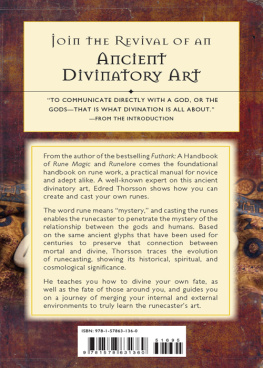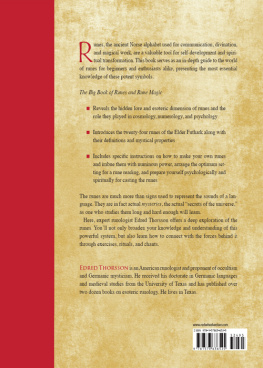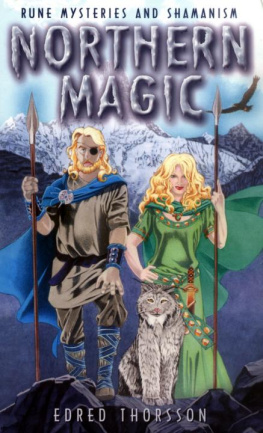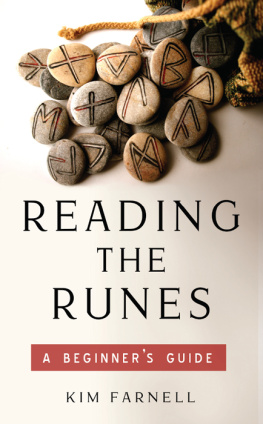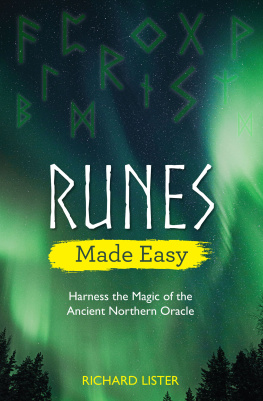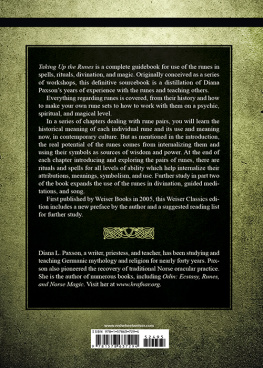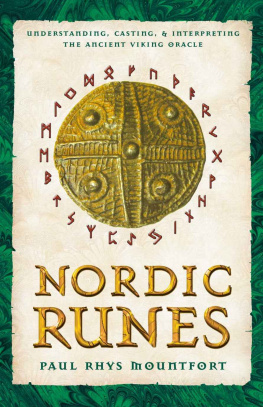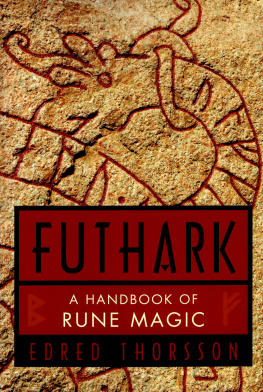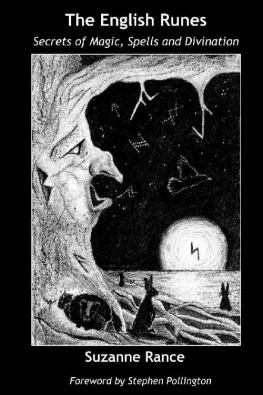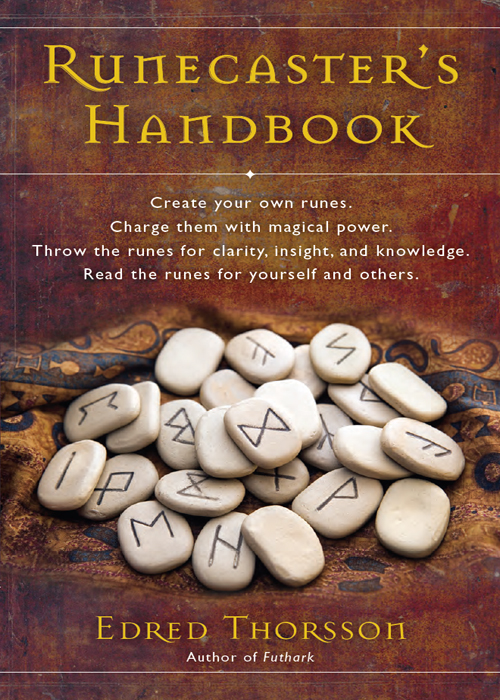


First published in 1999 by
Red Wheel/Weiser, LLC
With offices at
665 Third Street, Suite 400
San Francisco, CA 94107
www.redwheelweiser.com
Copyright 1988 Edred Thorsson
All rights reserved. No part of this publication may be reproduced or transmitted in any form or by any means, electronic or mechanical, including photocopying, recording, or by any information storage and retrieval system, without permission in writing from Red Wheel/Weiser. Reviewers may quote brief passages.
ISBN: 978-1-57863-136-0
Library of Congress Cataloging-in-Publication Data
Thorsson, Edred
[At the Well of Wyrd]
Runecaster's handbook : the Well of Wyrd / Edred Thorsson p. cm.
Originally published: At the Well of Wyrd. York Beach, Me. : S. Weiser, 1988.
Includes bibliographical references (p. ) and index.
ISBN 1-57863-136-X (paper : alk. paper)
1. Fortune-telling by runes I. Title.
BF1891.R85T56 1999
133.3'3--dc21 99-22822
CIP
Cover design by Claudine Mansour
Typeset in 11 point Goudy
Printed in the United States of America
MV
15 14 13 12 11 10 9 8 7
The paper used in this publication meets the minimum requirements of the American National Standard for Information SciencesPermanence of Paper for Printed Library Materials Z39.48-1984.
www.redwheelweiser.com/newsletter
For Nancy
Contents
Acknowledgments
Thanks go to Robert Zoller, James Chisholm, and Mitchell Edwin Wade for their help in researching the art of runecasting.
Preface
This volume is one of three in what has become a trilogy of runic handbooks. The other two, Futhark: A Handbook of Rune Magic and Runelore: A Handbook of Esoteric Runology, also are published by Samuel Weiser, Inc. In all of these books an effort has been made to combine the most traditional forms available with what we have been able to learn about the spiritual world of the ancient Germanic peoples through painstaking scholarly research galvanized by rational intuition.
Although the runic tradition is one full of innovative techniques, I have made a general practice in this book to stick to techniques, models of operation, and patterns of meaning for which we have good evidence within the old runic traditions. Innovation is encouraged, but at the level where it is most appropriate, with the individual. The sacred art of runic divination has been the most abused aspect of the tradition during this current runic revival. Perhaps this volume can begin to restore it. The approach to the Well of Wyrdcan be the holy road to the depths of the self and it is to this end that the book is dedicated. Those interested in continuing runic research are invited to write to:
The Rune-Gild
P.O. Box 7622
Austin, TX 78713
USA
Introduction
To communicate directly with a god, or the godsthat is what divination is all about. The runes on their most mundane level are a writing system. On both the mundane and the cosmic levels they are a system of communication. They are tools for reading otherwise hidden truths. Runes are a sort of traditional code, originally the gift of the god dhinn (Woden), through which messages can be sent from one level of reality to another, from one world to another. Whether in magic (galdr), where the runester's aim is to cause the objective world to conform to subjective will, or in runecasting, where the runester's aim is to read the hidden truths of his or her own subjective being or of the objective worlds, the runes are used as toolsas mediaby which messages may be sent and received.
In reality, of course, the true runes dwell within the soul of the runesterwithin you. The runestaves are symbolic objects which act as a kind of magical mirror of your soul. When you gaze upon the runestaves strewn on the holy cloth of white, you are truly gazing deep within the Well of Wyrd. As a runecaster, the vitki approaches the level of a priest or priestess (of a godhi or gydhja), someone charged to deal with the gods and to act as a communicator between the worlds of the gods and that of Midhgardhr. Most important, however, is the fact that anyone who takes the time to become skilled in runecasting will open unseen channels between the conscious and unconscious selves.
This opening of channels is won only after some effort and willpower have been spent. The would-be runecaster must learn much and work much before great success can be expected. In this book, together with information to be found in Futhark and Runelore, you will find all that you will ever need to become an effective runic communicator.
This book is intended to be a practical manual containing concrete indications of exact traditional lore and procedures; but it is not overly restrictive. Where the elder tradition is clear, we follow it, but in some technical matters we have had to reconstruct some details. This was done in the spirit of the Germanic and runic tradition. Each detail can be supported by some aspect or interpretation of the older tradition as it has survived in historical or literary sources. However, it is also an integral part of the Germanic and runic tradition to innovate where necessary. The potentially great runecaster will not hesitate to invent new forms or rune readings, casting methods, etc. Most runecastersand would-be experts on the subjectdo not err on the side of innovation, but depend too much on unthinking, rote borrowing from some other (usually later, more popular) system of divination. These borrowed elements then are shoved willy-nilly into the runic system.
Another problem often encountered in books on runic divination is that the writer is totally ignorant of the true traditionand prefers to remain so. The quality of your runecasts will be greater if you invest the time and energy to learn something before you begin casting (much less writing!).
Runic divination needs to be practiced before you can become skilled. This will require that you make many castings which probably will be undertaken with only a modicum of passion. You are urged not to make runecasting a profane form of play (for entertainment purposes); to this end the rituals should help. However, from a practical standpoint, how can you expect yourself to become proficient if you only undertake runecasts on important occasions? In the beginning, daily practice should be observed, though it is probably wisest not to undertake more than one casting per day. In this balanced way, a healthy respect for the runes, along with initiated familiarity will be gained in the shortest possible time.
Sometimes the runecaster poses a question to the runes, but the runes seem to be speaking to another point. The runes (i.e., your personal inner runes) tend to pick up the real question on your mind or in your heart. It is easiest to get accurate readings from these kinds of questions. More refined questions require more direction of the conscious will.
All in all, runecasting itself is perhaps the best method of getting to know the runes. Readingeven memorizingwhat the elder tradition says or what you find in Futhark and Runelore is fine, but the direct method of runester to runes is by far the most powerful way of learning about the mysteries. Skills in runecasting can be applied directly to all other aspects of runework and runecraft.
Next page
